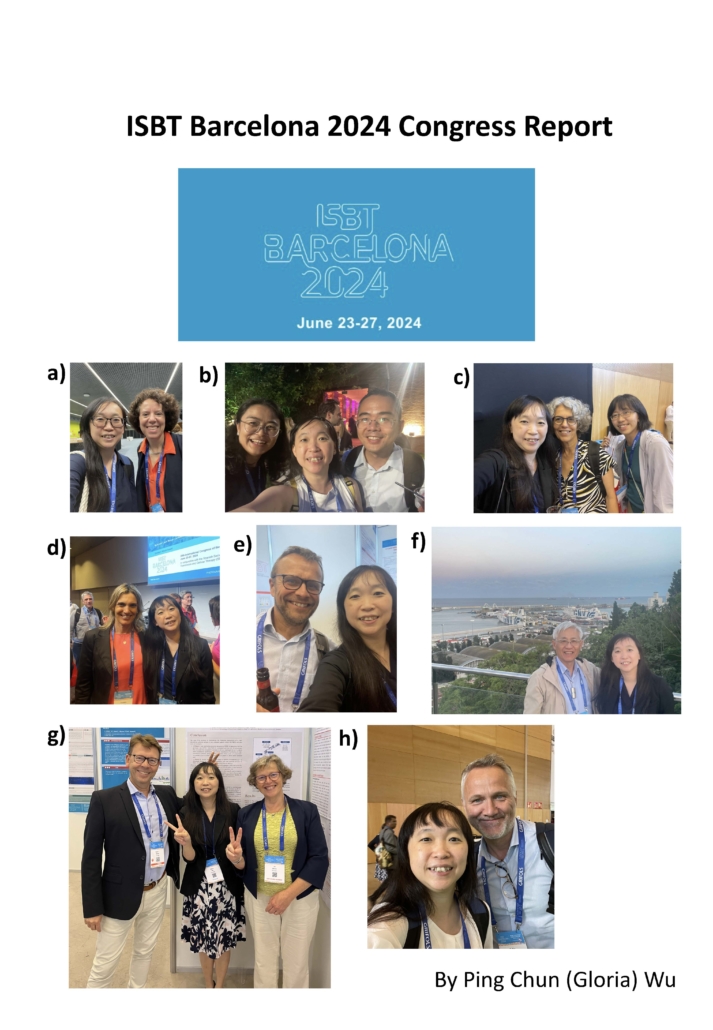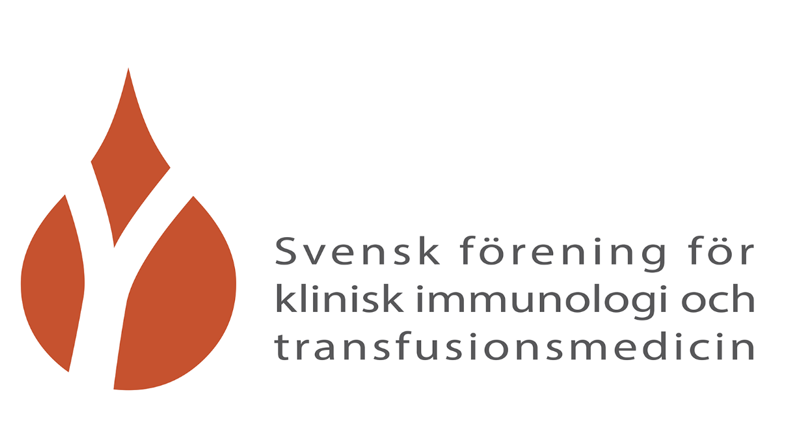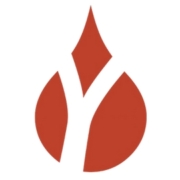Reseberättelser ISBT 2024 Barcelona
Reseberättelser från stipendiater Åsa Hellberg och Gloria Wu
Åsa Hellberg: Kortfattad vetenskaplig redogörelse:
ISBT (International Society of Blood Transfusion) arrangerar ett internationellt möte vartannat år, och i år hölls mötet i Barcelona. Konferensen som i år hade 3300 deltagare från 115 länder, är en viktig mötesplats för både forskare och kliniker inom transfusionsmedicin.
Kongressen inleddes redan på söndagen med utbildnings-sessioner för spanska deltagare. Jag är medlem i Red Cell Immunogenetics and Blood Group Terminology working party (RCIBGT) samt i subgruppen för cellfritt DNA, och dessa arbetsgrupper höll möte på söndagen samt under lunchen på måndagen. På arbetsmötet med RCIBGT godkände vi ytterligare två nya blodgrupper, nummer 046 MAL (fanns tidigare som AnWj i kollektionen 901009) och 047 ATP11C, samt två nya antigen i blodgrupperna Scienna och CTL2.
På subgruppsmötet som jag arrangerade tillsammans med Frederik Banch Clausen (FBC), diskuterade vi olika framtida samarbetsmöjligheter och tog del av en presentation om vilka metoder som används för blodgruppsanalyser med fetalt cfDNA. Dessutom presenterade jag preliminära resultat från en enkät FBC och jag skickat ut till laboratorier för att se hur blodgruppsanalyser med fetalt cfDNA avvänds på olika håll i världen. Enkätsvaren ska under hösten omvandlas till en artikel. På måndagsmötet med RCIBGT fick vi information om den nya databas som snart ska lanseras av ISBT. Databasen kommer att ersätta de tabeller med blodgruppsalleler som finns på ISBTs hemsida men med mycket mer information, vilket kommer att underlätta arbetet för oss inom transfusionsmedicin.
Huvudmötet startade på måndagen och fortsatte till torsdag kväll. Oftast pågick 5-8 olika föreläsningar samtidigt, vilket ibland gjorde det svårt att välja. Programmet täckte in ledarskap/organisation, donation, blodprodukter, cellterapier, transfusioner, transfusionsöverförda infektioner, blodgruppsimmunologi och genetik, varav den sista hade flest programpunkter som intresserade mig. Genetiska undersökningar tar allt större plats och används numera som en integrerad del på många laboratorier, både för att lösa serologiska problem och för att typa blodgivare.
Korta muntliga redogörelser av inskickade och utvalda abstrakt är också en del av programmet. Dessa sessioner var som alltid väldigt faktaspäckade och gav en god inblick i den forskning och metodutveckling som bedrivs på olika håll inom transfusionsmedicin.
Från kliniken hade vi skickat in två abstrakt, ett som beskrev en ny stor deletion i ABO-genen och ett som beskrev två patientfall med anti-Lu13. Båda abstrakten, som gjordes i samarbete med kollegor i Tjeckien respektive Frankrike, presenterades som posters. Martin L Olssons forskargrupp skickade in fyra abstrakt, där jag var medförfattare på två, och alla fyra valdes ut till muntliga presentationer.
Trombocyter diskuterades en hel del på mötet, dels kylförvarade trombocyter som har längre hållbarhet, dels lysat från utgångna trombocyter som kan används både som medium för att odla celler och för att behandla vissa sjukdomar. Även föreläsningen av årets Jean Julliard pristagare, Linda Schönborn, handlade om trombocyter. Schönborn var en lysande föreläsare som berättade om anti-Platelet Factor 4 (PF4)-antibodies vid vaccin-induced thrombotic thrombocytopenia.
Tiden mellan föreläsningarna använde jag till att diskutera och knyta/återknyta kontakt med andra deltagare. Det fanns även en stor företagsutställning med den senaste utrustningen inom transfusionsmedicin som var värd att besöka. Posterutställningen hann jag knappt se så abstrakten får läsas i efterhand. Årets kongress hade som brukligt även en fest för de deltagare som lyckats få en biljett. Vi bussades ut till en spansk lantegendom där det bjöds på mat, underhållning, dans och tillfälle att umgås med både nya och gamla bekantskaper.
Till slut vill jag tacka för stipendiet som möjliggjorde att jag fick deltaga i ISBTs kongress.

ISBT 2024 Congress travel report by Gloria (Ping Chu) Wu Date: 20240623* – 20240627 Place: Barcelona, Spain
*20250623 Invited as external guest for Red Cell Immunogenetics and Blood Group Terminology Working Party meeting.
It was as intensive congress with six days filled with dense scientific discoveries, development with varies aspects in the blood transfusion and immunotherapies, and networking mingling opportunities. In this report, I will summarize some of the highlights from the congress scientific sessions, workshops, working party meetings I participated, as well as provide some reflection and perspectives.
Presidential Award Session
This year the presidential award is given to Dr. Thierry Burnouf, who is an excellent researcher working on platelets and regenerative medicine, and also a professor based in Taiwan. I knew Dr. Burnouf before, we attend and present at the research meetings held by the Taiwan Blood Services Foundation, and even connect him to a clinician in National Taiwan University Hospital who works on helping patients recovered after eye surgery with its own platelet or platelet rich plasma (PRP). Therefore, it was very delighted to see a familiar face at the congress and to receive such a prestigious reward. Even as an outsider of the platelet world, I enjoyed Dr. Burnouf’s presentation, as it is a great introduction to the field and its applications. The title of the talk is “Platelet lysates and extracellular vesicles in cell therapy and regenerative medicine”. It begins about introducing the function of the platelets in human physiology, such as immunity, inflammation, and the main ingredients of the platelet lysates and also those you in find in the extracellular vesicles contains, and their roles in wound-healing, tissue-repairing and stimulating cell growth. Therefore, it is now applied to many fields of clinical care, besides the ophthalmology as mentioned above, it is also been applied to neurodegenerative diseases and even osteoarthritis. A pleasant surprise is to find that platelet lysates or the extracellular vesicles can also be utilized in cell culturing, replacing the use of bovine serum and allow the cells to grow, expand and thrive in similar ways.
I LOVE BLOOD GROUPS
Update on Immunohematology, New Horizons in Blood group genomics and Regulatory mechanisms, Advancements in blood group genetics in the genomics era, and working party meetings
One of the highlights of this congress for me as one studying blood group genetics and genomics are the development in this field and how the experts are planning the executing an accessible, expert curated, global database for the blood group genetics. The buzz of having such database has been planning for years with many behind the scene work done by the two very capable bioinformaticians in the field, Dr. Willam Lane from Brigham Women’s Hospital and Harvard Medical School and Dr. Nick Gleadall from University of Cambridge. In this year’s congress, we could see and play with the pre-release, pilot version of the database, demonstrated to us by the above-mentioned great experts. Alongside with the release of the new database, how to handle long read sequencing results and the haplotype sequences is an emerging topic that requires attention. I learned before the congress that there are several nations/laboratories such as Switzerland, France established a standard procedure utilizing long-read sequencing to genotype trouble cases. Long-read sequencing is a powerful tool not only for haplotyping for complex blood group genes as those from the ABO, RH, MNS systems, it also served as a wonderful tool to sequence the full-length mRNA, where you get the abundance for the transcripts with the variants residing on these transcripts. This application has been proven to be very useful in the study for the practical and clinical implications of the Del phenotypes presented by Dr. Yanli Ji from Guangzhou Blood Center. The Asian Del (RHD c. 1227G>A) is a synonymous variant, and it creates transcripts skipping exon 9 as the position of the variant is located at the last base pair of exon 9 and causes alternative splicing. However, with the long-read sequencing, it is showed that the Asian Del can indeed make full length RHD transcript but at a very low amount. This could be one of the reasons why these individuals are often without complications when transfused with RhD positive blood. Some of the talks that is in the same scientific sessions as I, are super interesting. One is presented by Dr. Jizhi Wen from Guangzhou on the novel discovery of the inversion of TMEM50A and RHCE together with deletion of the downstream Rhesus box. This novel allele is estimated to be in 4.1% of Chinese RhD positive donors. The focus of the genotyping is often on the weak expression or the negative ones. RH system being one of the most complex system harbors the most alleles by far due to the recombination of homologous RHD and RHCE genes. This study demonstrated even the so-called RhD positive individuals can harbor novel RH allele with complex structural variations. Again, here we see the application of longread sequencing. Another one is the study of In(Lu) and KLF1 variants by Dr. Luyi Ye from Shanghai. As myself has been thinking about the In(Lu) phenotype and try to study possible mechanism of how KLF1 can influence the phenotype for some period of time now, Dr. Ye’s study was surely a good surprise. In her presentation, she demonstrated that the mutated KLF1 does not modify nuclear localization or expression level of KLF1, but they can inhibit the interaction of KLF1 and the promoter of BCAM, while the interaction with promoter of HBB remain unaffected. The HBB remain unaffected is a contradictory to what we would normally assume considering KLF1 plays a key role for HBB expression. Nevertheless, I thought her work lies a good foundation that could to be expanded, and possibly take into consideration of non zink-finger linker-related-mutated KLF1, and perhaps introduce some nucleotide variations in the promoter sequence of BCAM to observe the expression level under these changes. Poster-session, networking, mingling and interesting chats with new and familiar faces The best part of the in-person conferences is that you get to interact with people, make new friend, and catch up with old ones. This congress definitely served as a wonderful platform in this domain. In this congress, I met with (a) Dr. Margaret Keller after we’ve together working on the ISBT allele table for Knops blood group system. I always love her enthusiasm and her sharpness in managing details in the meeting and in the tables. It was lovely to meet her and get to know her experiences in the reference laboratory for the American Red Cross. (b) Dr. Yanli Ji who I get to know and quickly become a very inspiring conversation partner since 2017 ISBT in Guangzhou. (c) Dr. Vered Yahalom from Israel, the chair of the Rare Donor Working Party, my old colleague Lei Fang Tsai from Taipei Blood Center and I had a wonderful chat with Dr. Yahalom when she came to Lei Fang’s poster, discussing how to strategize algorithms hunting for rare donors. (d) Dr. Donatella Londero from Italy, in her presentation for the session “Blood group genotyping: an important tool to resolve serology discrepancies“, she referenced to my very earliest work on targeted next-generation sequencing to resolve ABO blood group discrepancies. It is always a great surprise to meet someone who have read and appreciate your work. (e) Dr. Peter Bugert, my opponent for my PhD examination. It was such a delight to see him again and even communicate through the ISBT app to help answer some of the questions he had for one of the presentations that I am also involved with. My previous, current and future employer, (f) Mr. Sheng Tang Wei, the CEO of Taiwan Blood Services Foundation, (g) Prof. Martin L. Olsson and his lovely counterpart Prof. Jill R. Storry from Lund University, and (h) Dr. Petter Höglund from Karolinska Institute. It is really a privilege to work with brilliant people, and great thanks for them fostering a thriving environment to help you become a better version of you.



